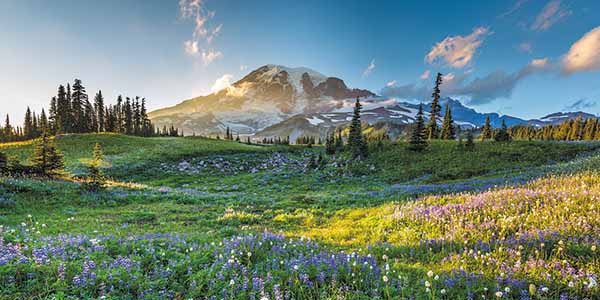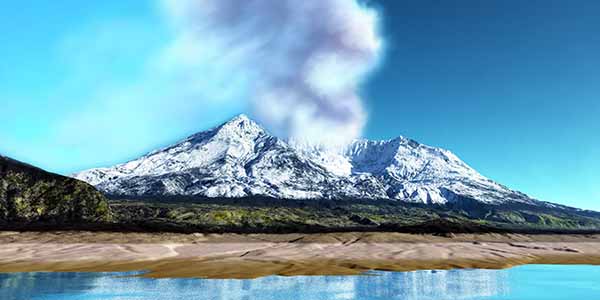Mount Rainier & Mount St. Helens
The natural world seems larger than life in the Evergreen State, especially in Mount Rainier and Mount St. Helens. These titanic peaks are shrouded in myth and majesty, enticing hikers to exploring their seemingly endless slopes.
Peak Experiences
Located 65 miles southeast of Seattle, Mount Rainier soars 14,411 feet into the sky, and its distinctive silhouette is plastered on every license plate in Washington. The daunting mountain leaves visitors open-mouthed with its cathedral-like groves of ancient trees, cascading waterfalls and the biggest glacial system in the continental United States. Drive 50 miles south to Mount St. Helens, where the largest landslide in recorded history occurred after a volcanic eruption in 1980. From roaming through lava tubes to a multifaceted landscape that’s still recovering today, this unique site lets you witness Mother Nature’s sheer power while spoiling you with myriad outdoor adventures.

Getty Images/iStockphoto
Conquer Washington’s highest peak
Mount Rainier is an active volcano covered in glaciers, old-growth forests and wildflower meadows. Get to the summit by riding the Mount Rainier Gondola and soak up panoramic views of the Cascade Range on your way up. You can also admire the landscape from the comfort of your car. Drive down the White Pass or Chinook scenic byways and look out the window to see river valleys, snowcapped peaks and charming mountain villages.
Rainier by Foot
Another way to experience this Washington icon is by following some of the more than 260 miles of maintained trails in Mount Rainier National Park. The most famous is Wonderland Trail, a 93-mile multiday journey that takes you around the entire mountain. Just as renowned is the family-friendly Grove of the Patriarchs Trail, which leads you to huge trees well over a thousand years old. If you’re keen to encounter wildlife, stroll the Sourdough Ridge Trail at sunrise to spot endearing marmots. Equally stunning is the Reflection Lakes Trail, famous for beautiful water and wildflowers.
Where Fish Always Bite
The waterways clustered around Mount Rainier are revered for their robust fish populations. Mineral Lake is considered one of the best trout fishing lakes in western Washington, so cast a line from there from late April to late September to score big. Silver Lake houses everything from largemouth bass to catfish and is replenished with approximately 30,000 rainbow trout every April. Local anglers also recommend the Tieton River if you want to catch whitefish and Carbon River for winter salmon or steelhead. Other popular fishing spots include the Nisqually River, Skate Creek, Leech Lake and Packwood Lake.
Whole Lava Adventures
You’ll find more adventures at Rainier’s counterpart, which stands 8,366 feet and packs a powerful history. The south end of Mount St. Helens is home to Ape Cave, the third-longest lava tube in North America. This natural wonder was formed thousands of years ago by a lava stream and randomly discovered by a logger in 1947. It was named after the St. Helens Apes, the Boy Scouts who were the first to explore the cave entirely in the 1950s. You can follow in their footsteps by traversing the 1.5-mile round-trip Lower Ape Cave Trail or the more challenging Upper Ape Cave Trail.

Getty Images/iStockphoto
Lava Canyon
Nearby is the Lava Canyon Trail, a 5-mile loop weaving through waterfalls and a deep gorge. What makes this trail fascinating is that it gives you an idea of how powerful the 1980 eruption was. The gorge it passes was once filled by sediment and then completely cleaned out by mudflows during the blast.
Windy Views
Beyond the south side is another 200 miles of trails. In the east, stop by Windy Ridge Viewpoint to see the crater up close and trek along Norway Pass for stunning wildflower fields and sweeping mountain views. In the west, hike Hummocks Trail to reach a dramatic landscape of ash, rock and mud, which was created by the massive eruption. Climbing to the top of the mountain is also possible as long as you have a permit.
Festivals With Wide Appeal
There’s a lot more than outdoor recreation going on in this alpine region. Discover local filmmakers by attending screenings and workshops at the Rainier Independent Film Festival, held every May in the Ashford Valley. In the summer, savor a variety of Washington wines at the Mount Rainier Wine Festival. You can also board the Washington Wine Express during three fall weekends to enjoy wine tastings and a scenic ride through Mount Rainier’s southern foothills. For a taste of Scotland, check out the Pacific Northwest Scottish Highland Games in the area for Highland dancing, bagpiping and food vendors serving haggis.
Blast from the past
Mount St. Helens blew its top on May 18, 1980, leaving charred terrain, billows of ash and a horseshoe-shaped crater over a mile wide. Fast forward nearly 40 years and the area has transformed into an ecological wonderland with a growing wildlife population and pink lupines blanketing the pumice plains. You can learn more about the eruption and recovery of the blast zone at the Mount St. Helens Visitors Center. Located just off Highway 504, this information point features a massive step-in model of the volcano and live feed showing Mount St. Helens’ current volcano seismicity. Outside, you’ll find a vantage point with panoramic views.
See the Stars
The Johnston Ridge Observatory is 50 miles east in the heart of the blast zone. Take a seat in its theater to watch footage of the blast and then view rock samples from nearby lava flows. Afterward, follow the half-mile Eruption Trail behind the building to see the lava dome, crater and landslide deposit with your own eyes.
For More Information
Mount St. Helens
360-274-7750
www.mountsthelens.com
Washington State Tourism
800-544-1800
www.experiencewa.com







